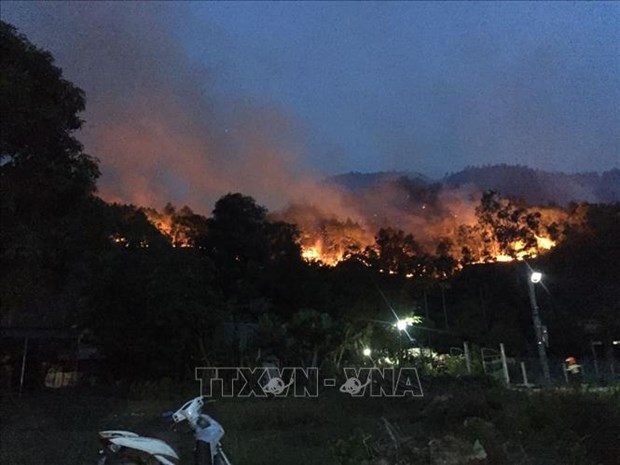 Society
Society

As many as 160 forest fires were reported across Việt Nam in the last six months, destroying about 756ha of forest, according to the Việt Nam Fire and Rescue Police Department under the Public Security Ministry.

|
| A forest fire happens in Mồng Gà Mountain in Hương Sơn District, Hà Tĩnh province on June 30, 2020. — VNA/VNS Photo |
HÀ NỘI — As many as 160 forest fires were reported across Việt Nam in the last six months, destroying about 756ha of forest, according to the Việt Nam Fire and Rescue Police Department under the Public Security Ministry.
During the same period last year, 156 forest fires were reported nationwide, destroying 930 ha of forest. Notably, the total area of destroyed forest last year increased by 64 per cent compared with the figures of the first half of 2018.
According to the Forestry Department under the Ministry of Agriculture and Rural Development, last year’s peak for forest fires fell between June 26 and July 1, mostly in the central provinces of Nghệ An, Hà Tĩnh, Quảng Bình, Quảng Trị, Thừa Thiên-Huế, Đà Nẵng, Quảng Ngãi and Phú Yên.
Now with northern and central provinces faced with a heatwave forecast to last days, the risk of forest fires has increased.
The National Centre for Hydro-Meteorology Forecasting on Thursday reported that most northern provinces on Wednesday experienced temperatures up to 38 degree Celsius, while central provinces from Thanh Hoá to Phú Yên saw the mercury rise to more than 39 degrees Celsius in some areas.
The temperature was reportedly higher on Thursday as provinces from Thanh Hoá to Quảng Trị saw 37-40 degrees Celsius and even more than 40 degrees in some areas.
The weather forecasting centre said the heatwave would continue.
Meanwhile, in the central province of Thanh Hoá, on Thursday, a forest fire lasted more than seven hours in two communes – Hải Nhân and Ninh Hải – in Tĩnh Gia District.
The fire started at noon and spread to an area of about 50 ha.
Earlier, on June 29, a fire raged for six hours in the central province of Nghệ An. It began at about 8pm in a pine forest in Diễn Châu District’s Diễn An Commune. Hot weather and strong winds caused the fire to spread over dozens of hectares of pine forest. More than 200 households who live near the fire were evacuated.
On the same evening, another forest fire happened in Ân Phú Commune, Vũ Quang District in the neighbouring province of Hà Tĩnh. The fire then spread to two communes – Sơn Long and Sơn Trà – in Hương Sơn District. It took nearly two days to control the fire.
Dozens of hectares of pine and acacia forest on Sơn Thành Commune, Yên Thành District, Nghệ An Province were destroyed by fire.
Common causes
Prolonged heat with temperature up to 43 degrees Celsius in central coastal areas in the last 12 days of June was blamed as the main cause of forest fires.
High temperatures and humidity of less than 30 per cent made forests more vulnerable to fire and once the fires happened, it was hard to extinguish them.
Poor quality of forests has been mentioned as a factor that increases the risk of forest fires in central provinces, Vietnam News Agency reported early this week.
In central Việt Nam, primary forests account for only 7 per cent of total forests and the remaining forests are secondary forests.
Of the secondary forests, impoverished ones account for about 70 per cent.
The secondary forests are said to be more sensitive to fire than primary ones.
Pine forest, Melaleuca forests, bamboo forests, eucalyptus forest, dipterocarp forest are easily flammable. These kinds of trees are very common in the central region with a total area of nearly 6 million hectares.
Human activities, especially burning in forest areas, also cause forest fires.
According to Nghệ An Province’s Forest Protection Division, four out of nine forest fires in the province since the beginning of this year were related to human activities.
Modest funding, lack of equipment and staff are also problems in forest fire prevention and control.
Forest environment services
Since 2011, Việt Nam has been implementing a national payment for forest environmental services (PFES) scheme that has mobilised thousands of households to protect and manage more than 5 million hectares of forest land.
More than $230 million has been disbursed to participating households in 40 provinces and the socioeconomic and conservation benefits have been well-regarded.
PFES schemes are based on environmental service ‘users’ rewarding or compensating ‘providers’ of those environmental services.
The northern mountainous province of Sơn La has run PFES since 2009.
Out of 637,018ha of forest in the province, 537,000ha has been protected and developed with funding from the PFES policy, thus, the quality of forest and forest biodiversity has improved regularly.
In the northern mountainous province of Lai Châu, PFES also helps reduce forest fires.
Task forces were established at every commune in the province, responsible for patrolling and protecting certain forest areas as well as detecting potential risks/violations. The task forces are paid with the funding from PFES.
Vàng Thị Thánh, chairwoman of Num Nưa Commune People’s Committee in Mường Tè District, said local authorities strengthened communicating on forest fire prevention and control to local residents, especially during the dry season.
More than 4,000ha of forest in the commune was protected by its task forces.
According to Mường Tè District People’s Committee, it set up 126 task forces specialising in forest fire prevention and control. For the last few years, no forest fires have hit the district. — VNS




